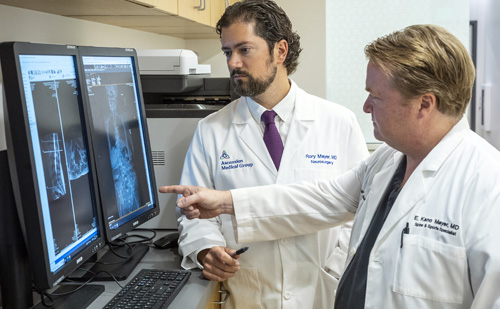Treatment
Mini Scoliosis Surgery
 New treatment options for spinal curves
New treatment options for spinal curves
There are two new minimally invasive procedures that do not involve fusion, and can be used to treat those younger patients — typically in their teenage years — who have spinal curves that have not responded to bracing.
Both of the new surgical procedures access the spine through tiny incisions near the ribs:
- Vertebral Body Stapling uses a series of staples on one side of the vertebrae to correct scoliosis like braces on teeth.
- Vertebral Body Tethering uses a cable attached to one side of the vertebrae to correct and then control the curve.
- Both techniques work on one side of the curve to prevent it from worsening during the adolescent growth spurt. Sometimes it may be the only surgery needed. A second benefit of both minimally invasive techniques is that they don’t burn any bridges and more traditional corrective instrumentation can be used later on if necessary.
Another significant advance is “Minimally Invasive Scoliosis Surgery” which accesses the spine through shorter incisions instead of a single long 10-inch incision involved with traditional scoliosis surgery.
Dr. Rory Mayer and is proficient in minimally invasive scoliosis surgery. Dr. Matthew Geck at Texas Spine & Scoliosis Center is also proficient in “mini scoliosis surgery” which accesses the spinal curve through three separate incisions.
The benefit of the minimally invasive approach to the patient is significant:
- The shorter incisions involve less blood loss and no need for outside blood.
- The shorter incisions have less disruption to muscles and tissues and subsequently the patient has a less painful and quicker recovery.
- The patient has less risk of complications and spends less time in the hospital.
- In scoliosis surgery metal rods, screws or wires are used to de-rotate the curve. Scoliosis surgery is based on a two-rod instrumentation system with hooks that attach to each vertebral level to de-rotate and straighten the abnormal curve.
With adults, the concern is that the older the patient, the less the flexible the spine is for correction, and the more risk for spinal cord damage during correction. In this case, waiting years to deal with progressing scoliotic curves can be a disadvantage.
The good news about scoliosis is that the vast majority of people diagnosed with some degree of scoliosis can often live normal, active and healthy lives.

